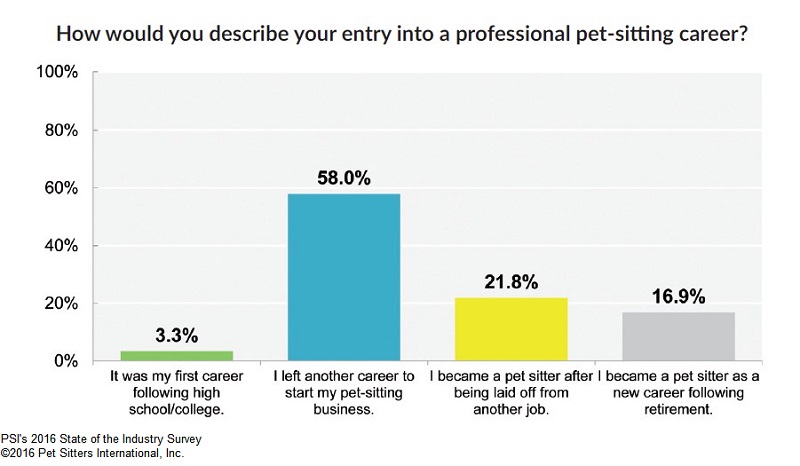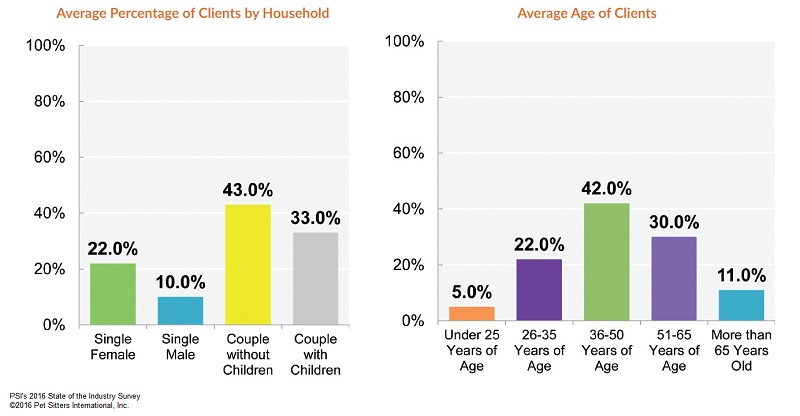Pet Sitters International releases 2016 State of the Industry Survey results
PSI’s 2016 survey results reveal that women still dominate the pet-sitting industry, and dogs and cats remain the most frequent beneficiaries of professional pet-care services.

Pet Sitters International (PSI), the world’s leading educational association for professional pet sitters, has released its 2016 State of the Industry Survey, revealing that PSI’s member pet-sitting businesses performed more than 17 million pet-sitting assignments and generated more than $391 million in pet-sitting revenues last year.
PSI announced the results of its 2016 survey at its conference in San Diego this month. The association’s survey—conducted every two years—is the most comprehensive survey of its kind for the professional pet-sitting industry, gathering data about gross business revenues, types of services most offered, average charges for services and more.
“We agree with the more than three-quarters of members who said their outlook for their businesses and the pet-sitting industry in general was ‘positive’ or even ‘the sky’s the limit’ in the coming years,” PSI President and Founder Patti J. Moran told PSI members on Sept. 12 at the Pet Sitter World Educational Conference & Expo.
PSI conducted its survey exclusively online from Feb. 1, 2016, to Feb. 29, 2016. Email invitations to participate were sent to PSI’s nearly 7,000 member businesses, and 28.5 percent responded.
PSI uses the survey results to develop an accurate PSI member profile and to examine pet-sitting industry trends.
Who are these pet sitters?
According to PSI’s 2016 survey, nearly 100 percent of its pet-sitting businesses are independently owned, and the majority of businesses are owned solely by women (nearly 83 percent). Ninety-five percent of PSI’s member businesses are insured, and 83 percent carry both liability insurance and bonding.
Additionally, these pet sitters have completed at least some college (90 percent), with 33.6 percent having obtained bachelor’s degrees and 13.8 percent pursuing graduate level studies.
Fifty-eight percent of PSI’s pet sitters left another career to start their pet-sitting businesses, and the average age when PSI members opened their pet-sitting businesses was 43.

What pets are they caring for?
Dogs and cats are still the species pet-sitting businesses most commonly offer services for—96.1 percent and 95.5 percent respectively—but more than half of the pet sitters responding to the survey also offer services for birds, fish and cage pets. There has been a jump in the number of pet sitters who offer services for chickens or barnyard fowl. In 2014, around 58 percent of sitters who offered livestock care said they offered care for chickens, while this year the percentage jumped to 85.4 percent.
The vast majority of PSI members offer basic pet-sitting visits, dog walking or both, but more than half also offer overnight sits and pet transportation. About 90 percent also indicated they offer pet-sitting services or medication administration to special-needs pets, and about three-quarters do not charge extra for this service.
Who is using professional pet sitters?
PSI’s survey found that the pet-sitting client demographic has changed little since the 2014 survey. On average, the typical pet-sitting client is a married couple between the ages of 36 and 65, and client bases include more married couples without children in the home (43 percent) than couples with children in the home (33 percent).
Clients under the age of 25 only make up 5 percent of PSI members’ clientele, but Moran advises pet sitters to keep an eye on this demographic.

“Millennials often view their pets as their children, just as many Baby Boomers do,” Moran told pet sitters in San Diego, “and this dedication to their pets, along with their growing spending power, make them ideal clients if you can reach them and explain the benefits of professional pet sitting.”
PSI’s 2016 State of the Industry Survey also collected data on marketing and advertising preferences, social media and technology use, and detailed business practices.
To learn more about PSI’s survey or about professional pet sitting, visit http://www.petsit.com.






